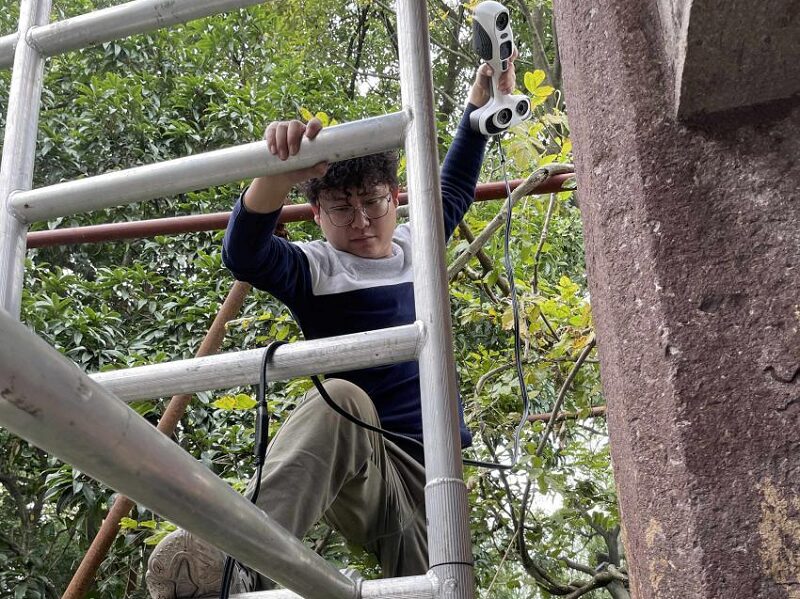Tracing the 3D Scanning and Restoration Process of the Mid-Lake Pavilion and Ding Henian’s Tomb Pavilion
10/17/24
Cultural relics, bearing the memories of history and the essence of culture, are the common precious heritage of humanity. However, as time passes, the erosion of the natural environment, along with the impact of human factors, poses numerous challenges to the conservation of cultural relics. Against this backdrop, the application of digital technology offers new possibilities for the preservation of cultural heritage.
I. Project Background
1. Mid-Lake Pavilion
The Mid-Lake Pavilion, renowned as one of China’s four famous pavilions, stands in the heart of West Lake in Hangzhou, Zhejiang. This three-tiered pavilion with ornate eaves and glazed tiles is a testament to Chinese craftsmanship, featuring dragon and phoenix carvings. Once part of the Mid-Lake Temple, it has been reconstructed over the years and is nestled among lush vegetation, making it a historically significant island in the West Lake.
2. Ding Henian’s Tomb Pavilion
Ding Henian’s Tomb Pavilion, located in Liulang Wenying Park near West Lake, Hangzhou, is a Ming Dynasty reconstruction of a Yuan Dynasty original. A provincial cultural relic, this hexagonal stone pavilion with a double-eaved roof faces east, exuding an ancient charm. Inside, an Arabic-style tomb cover is accompanied by inscriptions detailing the heritage and biography of the Yuan Dynasty Hui poet, Ding Henian.
II. Technical Methods: The Application of iReal 2E and SIMSCAN in the Digitization of Cultural Heritage Conservation
In the restoration project of the Mid-Lake Pavilion and Ding Henian’s Tomb Pavilion, ScanTech utilized both the iReal 2E and SIMSCAN devices for 3D scanning.
1. Features and Advantages of the iReal 2E 3D Scanner
(1) The device offers fast scanning capabilities without the need for markers, allowing for rapid and efficient collection of 3D data;
(2) It boasts a wide Field of View (FoV) and scanning depth, ensuring smooth scanning for medium and large-sized objects.
(3) Utilizing infrared VCSEL structured light technology, it possesses outstanding adaptability to various lighting conditions, maintaining stable scanning performance in both dimly lit indoor environments and direct sunlight outdoors.
2. Features and Advantages of the SIMSCAN3D Laser Scanner
(1) Equipped with an ultra-high-definition camera module, it offers three scanning modes with a measurement precision of up to 0.020 mm, capable of capturing details accurately, including complex surfaces and areas that are difficult to access directly;
(2) Compared to other handheld 3D scanners, SIMSCAN has a shorter distance between its two cameras, making it particularly suitable for scanning concealed areas such as deep grooves and channels that are hard to observe, ensuring the completeness of data collection;
(3) Compatible with the wireless power module AirGO Power, when used in conjunction with it, the device allows for real-time screen projection on mobile devices, greatly enhancing the flexibility, portability, and efficiency of 3D scanning.
III. The 3D Scanning Process of the Mid-Lake Pavilion and Ding Henian’s Tomb Pavilion
In the restoration project of the Mid-Lake Pavilion and Ding Henian’s Tomb Pavilion, we utilized both the iReal 2E and SIMSCAN 3D scanning devices. The iReal 2E was primarily responsible for scanning the overall structures, while the SIMSCAN was used to accurately capture the fine components and details. By using these two devices in conjunction, our aim was to compare and analyze the overall and localized deformation of the stone cultural relics before and after restoration, thereby assessing the restoration effectiveness. The following are the size overviews of the two relics:
– Mid-Lake Pavilion dimensions (1.7 meters * 8.6 meters * 5.6 meters)
– Ding Henian’s Tomb dimensions (height 5.25 meters)
During the project execution, we faced the following challenges:
(1) Safety of scanning operations: For the high-altitude work required on the top of the stone gate of the Mid-Lake Pavilion and at Ding Henian’s Tomb Pavilion, we implemented strict safety measures to ensure the safety of the staff;




(2) Optimization of data processing: The raw three-dimensional data contained over 500 million points of cloud data, and after processing, the mesh volume reached 2 billion. In this process, we needed to find the best data simplification strategy to maintain data accuracy while improving the speed of data processing;


(3) Alignment of scanning data: Merging multiple separate scanning segments into a single complete 3D model is a complex task. During this process, we continuously faced challenges such as missing data, overlaps, and errors, which needed to be addressed one by one to achieve precise model assembly.


During this period, ScanTech collaborated with the Hangzhou West Lake Waters Management Office and the Zhejiang University Cultural Relics Conservation Materials Laboratory to conduct two 3D scans of the Mid-Lake Pavilion restoration project, one before and one after. These scan records provided us with precise 3D data of the pavilion, which was crucial for analyzing the overall structure of the relics, localized deformation, and assessing the restoration effectiveness. Through this series of professional operations, we not only contributed technical strength to the conservation of cultural relics but also accumulated valuable experience in the digital preservation of cultural heritage.
IV. Results: The Application Value of Digital Preservation in the Restoration of Cultural Relics
The use of 3D scanning in the restoration of the Mid-Lake Pavilion and Ding Henian’s Tomb Pavilion has led to precise digital records and analyses. These data have been instrumental in guiding the restoration process and ensuring the long-term preservation of the relics’ historical integrity. The expertise of ScanTech has significantly bolstered the technical aspects of cultural heritage conservation.
In essence, digital technology is pivotal in preserving our cultural heritage. The successful application in these projects underscores the transformative potential of digital tools for the continuation and evolution of cultural relics. It is imperative to further explore and harness digital advancements, broadening their application in cultural conservation to protect and perpetuate our invaluable heritage.
Related Articles
View Our Product





